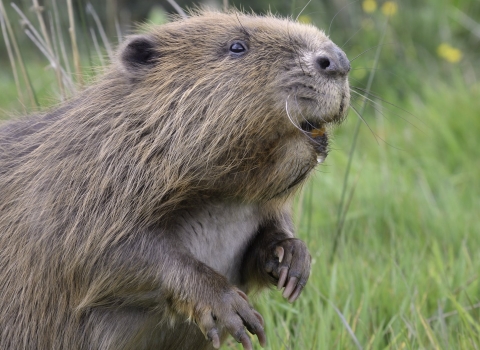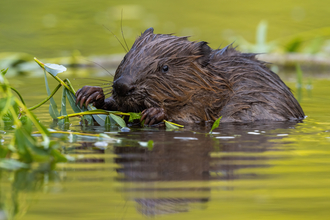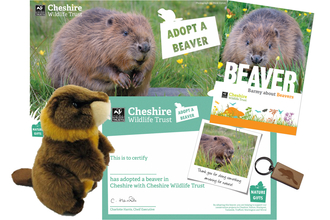Beavers in Britain
The Eurasian beaver (Castor fiber) is a large herbivore, a mammal that was formerly native to these shores and once played an important part in our landscape from prehistoric times until it was hunted to extinction in the 16th century for its fur, meat and scent glands. The loss of this charismatic species also led to loss of the mosaic of lakes, meres, mires, tarns and boggy places that it so brilliantly built.
The Wildlife Trusts are working hard to bring these fantastic mammals back to Britain.
Why do we need beavers?
This isn't just about the reintroduction of a species - it's about the reintroduction of an entire ecosystem that's been lost.
Beavers are often referred to as 'ecosystem engineers'. They make changes to their habitats, such as digging canal systems, damming water courses, and coppicing tree and shrub species, which create diverse wetlands. In turn these wetlands can bring enormous benefits to other species, such as otters, water shrews, water voles, birds, invertebrates (especially dragonflies) and breeding fish.
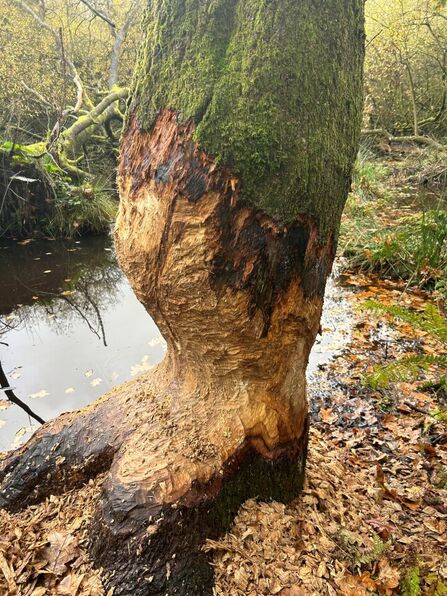
Beavers and the landscapes they generate benefit both people and wildlife because:
- They help to reduce downstream flooding - the channels, dams and wetland habitats that beavers create hold back water and release it more slowly after heavy rain
- They increase water retention
- They clean water
- They reduce siltation, which pollutes water
Beavers are known as nature's engineers. They make changes to their habitats which create diverse wetlands for other species to thrive.
We've brought beavers back
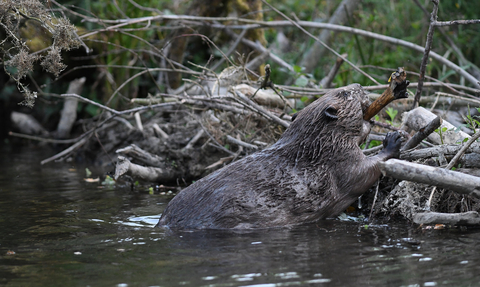
David Parkyn/ Cornwall Wildlife Trust
Be part of bringing beavers back
Frequently asked questions
Are beavers native?
- Beavers are a native species to Britain and were lost from our wetlands a few hundred years ago
- Eurasian beavers (Castor fiber) are found across Europe and much of Asia
- They were hunted to extinction for their fur, meat and castoreum
- We recognise a native species as one that recolonised Britain as the ice retreated at the end of the last ice age
- There is also a Canadian species of beaver, these are not native to Britain and are not the species we're re-introducing
Why beavers?
- Beavers are a “keystone species” which play an important role in restoring British wetland ecosystems. They naturally create resilient networks of prime wetland habitat, which in turn produces natural capital benefits such as flood relief and benefit a wide range of species including amphibians, fish and bats.
- Beavers naturally engineer watercourses to create deeper water so they can escape from predators and explore their territories. Where there is no existing deep water, they will create pools using small dams.
- Multiple trials, including the Scottish Beaver Trial and the River Otter Beaver Trial show huge improvements to wildlife, water quality, flood reduction, sediment reduction and more where beavers are re-introduced.
- There are habitats specifically created by beavers that are lacking in Britain, including beaver meadows, beaver dams and flooded wet woodland.
- Beavers can play a key role in increasing woodland, wetland, open water and riparian vegetation and wildlife diversity
- Wetlands are some of the most important habitats for supporting wildlife, and as such, their restoration is crucial to the restoration of a healthy living landscape.
- In a 2.8 hectare enclosure in the Devon Beaver Trial , in 7 years, beavers : -
- Created 650 m² of open water
- Increased water storage from 50 m³ to 1000 m³
- Reduced the flood peak by 30%
- Increased the time for floods to flow through the site from 15 mins to 1 hr
- Enhanced the summer baseflow (mitigating drought)
- Had 3 x less sediment leaving the site than entering it
- Trapped 70 kg per m² of sediment - of which 70% entered the site as run off from just a 20 ha piece of land upstream.
- Had 5 x less Phosphate pollution leaving the site
- Increased frogspawn clumps from <20 to >600
- Stored around 15 tonnes of carbon in 13 ponds
What is a keystone species?
A keystone species is a species which plays a unique and critical role in the way an ecosystem functions, or in the structure and health of a habitat. The presence of keystone species determines the types and numbers of other species found in that environment. Without keystone species, the habitat is dramatically different, usually far less healthy, and in many cases, ceases to exist. An analogy is the keystone in a brick arch. If you remove the keystone then the arch collapses. When beavers were removed from Britain, the habitats they supported collapsed.
Do beavers cause flooding?
- Beavers can make rivers less prone to flash floods, reducing flooding by holding water in ‘the right place’ in river headwaters, and enabling the slower release of water in drier periods.
- A project with the University of Exeter in the River Otter has studied the impacts of beavers on water flows and hydrology in great detail. The preliminary results are remarkable and show that beavers tend to decrease flooding overall.
- It is important to differentiate between the storage of water by beavers in river headwaters, and the impact of beavers on low lying land. In some places, culverts and drainage systems, some of which are critical to reducing flood risk, need to be kept clear of beaver debris.
- In order to create habitat for themselves, and to store water upstream, beavers need to temporarily and seasonally flood areas of land to create beaver ponds. This can be managed so that they do this in areas where flooding is wanted.
- There will be low lying agricultural or developed areas in floodplains where beavers may need to be actively discouraged from causing flooding.
- In the event of an emergency relating to flooding, please contact the EA 24hr Floodline 0845 988 1188. Any emergency relating roads or other highways, call 0845 155 1004 or 0345 155 1004.
Do beavers carry diseases such as Bovine Tuberculosis?
- The beavers released are health checked to make sure that they do not carry any infectious parasites or diseases, and that they are fit for release both from a disease and a welfare perspective.
- The introduced beavers were all healthy and free of any significant diseases, including the tapeworm Echinococcus and bTB.
- There is no evidence from Europe to suggest that Eurasian beavers carry bovine tuberculosis bTB. As most mammals can be infected by bTB it is theoretically possible for beavers to become infected if they are exposed in English landscapes. Scotland – where the Knepp beavers are being sourced from – is currently bTB free. DEFRA has agreed that Scottish beavers therefore do not need to be tested for bTB.
What do beavers eat?
- Beavers coppice trees to create dams. Sometimes this is perceived as eating. Many of the trees beavers cut for damming, are species like willow which will grow and re-root where they are ‘planted’ by the beaver
- In summer, beavers graze mostly on riverside plants and grasses. In winter they feed mostly on tree bark and shoots
- Beavers like to eat willow and aspen trees, and to a lesser extent, alder. They will take fruit trees (particularly apple) and poplar trees if these are close to watercourses, and will leave the water to find these trees.
- Beavers tend not to move far from fresh water so impacts are often very close to the riverbank, generally within 30m
- Most native trees will naturally re-sprout when cut (coppicing). However in some instances browsing by deer and livestock, or flooding will prevent trees from re-growing
- Special trees can easily be protected from beaver activity
How far from water do beavers cut trees?
- Beavers are well adapted to water and evolved over millennia to use water as a defence from predators
- While surprisingly fast over short distances, beavers do not like to travel too far from the water to cut down a tree
- Most trees that beavers cut down are within 30 metres of the water
- As beavers deplete the supply of food trees close to the pond’s edge they may raise the height of the beaver dam to bring the pond closer to more distant trees, or create a series of further dams to access other areas for foraging
- Another engineering method beavers employ is to excavate canals from the pond in the direction of the trees they wish to harvest. Once a tree is toppled they are able to cut off and transport the branches easier and more safely to the pond using their canal
- Beaver are “Nature’s Engineers” and much of their tree felling is of trees such as willow and poplar which will naturally coppice and regenerate after felling
Do beavers cut more at certain times of year?
- There tends to be a large initial cut when beavers first arrive in their new enclosure, which can be alarming for some people to see
- As beavers settle in for the first few months you may notice trees being cut as they build shelters and dams. Most of this is coppicing
- You may notice that beavers cut down more trees in late autumn. This is because they are stockpiling a food cache of sticks for the winter
- Beavers do not hibernate, so they plan ahead and store a cache of edible sticks underwater near their lodge in order to be able to eat if their ponds freeze. Once a pond is frozen over and they can no longer access new trees, they will swim out of their lodge, grab an underwater stick, and bring it back to the comfort of their lodge to eat the bark
- Remember that tree coppicing can look bare in winter, but that it will promote lush regrowth in the spring – a way of beavers helping to regenerate their own food supply
Do beavers prefer certain tree species?
- Beavers have a definite preference for certain trees. Preferred tree species include alder, aspen, apple, birch, cherry, cottonwood, poplar and willow. Aspen/poplar and apple are their favourite
- If the supply of their preferred trees is low they will harvest oaks and some maples
- Conifers such as pines, hemlocks, etc. are their least favourite
- Sometimes they will girdle (remove the bark around the entire base) of conifers for an unknown reason. One possibility is to obtain a much needed dietary nutrient
Do beavers eat fish?
- Beavers are entirely vegetarian (herbivorous) and don’t eat fish. Their presence is generally very positive for most fish species.
- The natural wetland habitats that beavers create often help to increase natural fish populations.
- Concern is expressed by some, about the ability of salmon and sea trout to get over dams. The science suggests that long term benefits generally outweigh any localised short term impacts.
- Natural woody material is a natural part of river systems and fish have migrated through these natural obstructions for millennia.
- Man-made obstructions to fish passage have a far greater impact on migrating fish populations.
How quickly do beavers breed?
- Beavers breed once a year, and have an average of 3 kits
- Beavers only breed at 2-3 years old
- Beaver kits are vulnerable to predation by foxes, birds of prey and maybe otters – so not all kits survive
- When first released, adult beavers initially colonise relatively rapidly over large distances (if not in fenced enclosures)
- Once territories are established, population numbers only rise slowly
- Beavers live in strict family groups, with only the dominant pair breeding
- At high densities, territorial behaviour regulates their populations
- Some beaver youngsters may choose to stay at home and help their parents rather than breed themselves when populations are at higher densities
- Beavers have territorial battles, in which they will sometimes kill their rivals
- Beaver numbers and the resources available to them will be monitored throughout the project to ensure animal welfare
- If the territories become saturated, we may need to re-home older offspring several years down the line
The Delamere Beaver Project
The Delamere Beaver Project aims to use natural process driven management to:
- Increase biodiversity, improve water quality and chemical composition and reduce sediment load at the reintroduction site.
- Enhance the conservation status of the adjacent Hatch Mere Nature Reserve.
Hatch Mere reserve is a SSSI and Ramsar site, these designations are given due to the rare animals and habitats found there which are currently under threat from poor water quality entering the mere. The enriched water supplied from the surrounding catchment is pushing out the sensitive habitats and leading to biodiversity loss.
In 2018, Cheshire Wildlife Trust took on the management of an area of land to the north east of Hatch Mere, which includes wetland habitats through which water flows into the SSSI. Given the influence of this drainage on Hatch Mere it was felt that this land could usefully be managed for multiple purposes of improving the habitat and water quality both on site and downstream through the reintroduction of beavers. The evidence for beavers restoring ecological function suggests we'd expect to see:
- A significant improvement in water quality contributing towards attaining favourable condition of neighbouring Hatch Mere SSSI and good ecological condition of neighbouring WFD water body
- A significant increase in carbon storage of underlying peat
- A significant rise in woody debris of all types
- A significant rise in ground water levels
- A significant increase in all wetland environments
- A significant reduction in invasive species
- A significant increase in biodiversity
In addition, we'd expect a rise in interest from local people and visitors to the area, providing an opportunity to raise awareness of the role that beavers could play in responding to the current climate and nature crisis, as well as making a contribution to the local economy.
In 2020, Cheshire Wildlife Trust released a pair of Eurasian beavers called Rowan and Willow into a 4.5ha enclosed site on one of the main inflows into Hatchmere Nature Reserve. This would not have been possible without the support of our members and supporters.
Over the last five years, the landscape has been transformed. What was once largely grassland and woodland has evolved into a thriving wetland, interlaced with beaver-built canals and dams. They have been breeding successfully since 2022 and the family have been helping to improve water quality.

